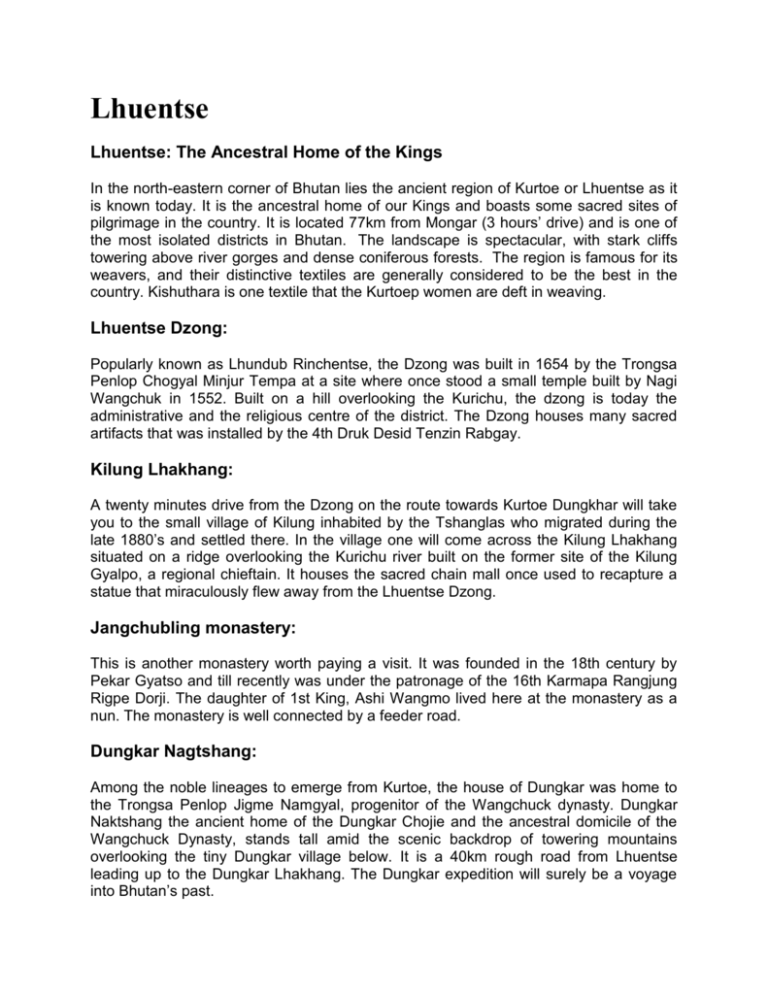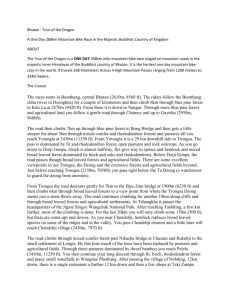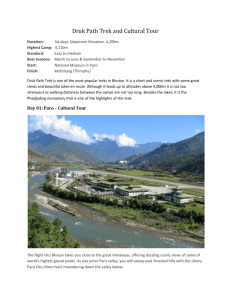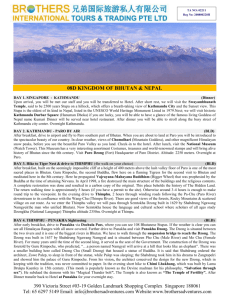Lhuntse
advertisement

Lhuentse Lhuentse: The Ancestral Home of the Kings In the north-eastern corner of Bhutan lies the ancient region of Kurtoe or Lhuentse as it is known today. It is the ancestral home of our Kings and boasts some sacred sites of pilgrimage in the country. It is located 77km from Mongar (3 hours’ drive) and is one of the most isolated districts in Bhutan. The landscape is spectacular, with stark cliffs towering above river gorges and dense coniferous forests. The region is famous for its weavers, and their distinctive textiles are generally considered to be the best in the country. Kishuthara is one textile that the Kurtoep women are deft in weaving. Lhuentse Dzong: Popularly known as Lhundub Rinchentse, the Dzong was built in 1654 by the Trongsa Penlop Chogyal Minjur Tempa at a site where once stood a small temple built by Nagi Wangchuk in 1552. Built on a hill overlooking the Kurichu, the dzong is today the administrative and the religious centre of the district. The Dzong houses many sacred artifacts that was installed by the 4th Druk Desid Tenzin Rabgay. Kilung Lhakhang: A twenty minutes drive from the Dzong on the route towards Kurtoe Dungkhar will take you to the small village of Kilung inhabited by the Tshanglas who migrated during the late 1880’s and settled there. In the village one will come across the Kilung Lhakhang situated on a ridge overlooking the Kurichu river built on the former site of the Kilung Gyalpo, a regional chieftain. It houses the sacred chain mall once used to recapture a statue that miraculously flew away from the Lhuentse Dzong. Jangchubling monastery: This is another monastery worth paying a visit. It was founded in the 18th century by Pekar Gyatso and till recently was under the patronage of the 16th Karmapa Rangjung Rigpe Dorji. The daughter of 1st King, Ashi Wangmo lived here at the monastery as a nun. The monastery is well connected by a feeder road. Dungkar Nagtshang: Among the noble lineages to emerge from Kurtoe, the house of Dungkar was home to the Trongsa Penlop Jigme Namgyal, progenitor of the Wangchuck dynasty. Dungkar Naktshang the ancient home of the Dungkar Chojie and the ancestral domicile of the Wangchuck Dynasty, stands tall amid the scenic backdrop of towering mountains overlooking the tiny Dungkar village below. It is a 40km rough road from Lhuentse leading up to the Dungkar Lhakhang. The Dungkar expedition will surely be a voyage into Bhutan’s past. Gangzur village: At a distance of two kilometers from the Dzong is situated the Gangzur village that is most popular for pottery. The women folk from the village are skilled artisans and adept in the art of pottery. A dying art, the Government has now tried to revive it through financial support. You can witness the women folk displaying their skills. Khoma village: A walk to this village will truly be a pleasant trip. Situated about two hours walk from the Dzong through gentle slopes amongst pine trees, this village is known throughout the country for its woven textile, the Kishuthara. A culture that has evolved over the years is a row of women in a makeshift textile cottage, weaving intricate designs and patterns. Picking up a Kishuthara will be much cheaper than buying one from the handicraft shops in the capital. Singye Dzong: The famed Singye Dzong, one of the most important sites of pilgrimage in Bhutan is a three days uphill walk from Lhuentse Dzong. It is located at an altitude of more than 3,000 meters. It is believed that Guru Rinpoche, the Precious Tantric Master once meditated here. Singye dzong is the main sacred place where Guru Rinpoche meditated. A journey to Singye dzong will be a rewarding experience.






